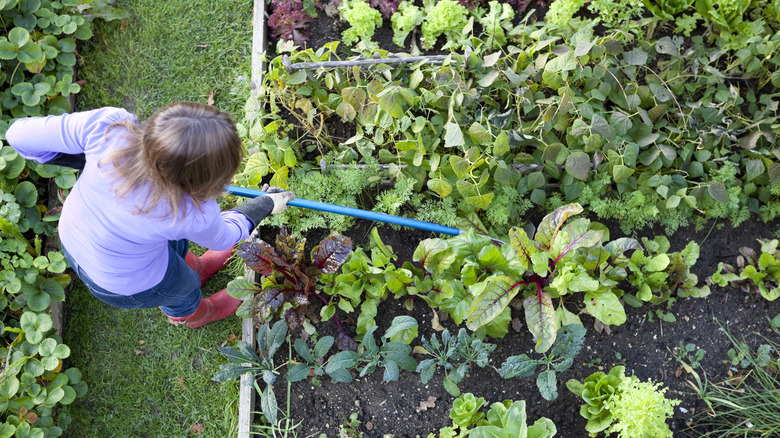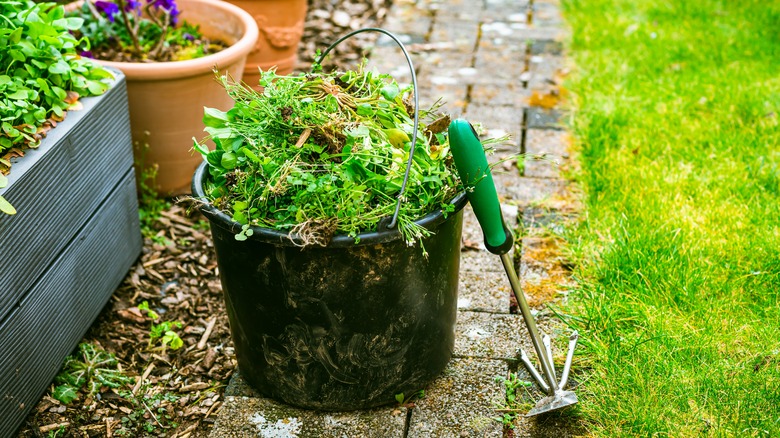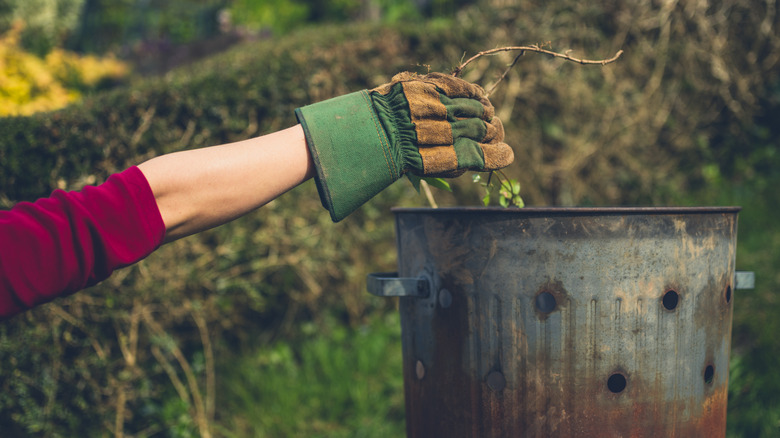The Weed Disposal Mistake That'll Have Them Growing Back In No Time
Sometimes, it seems like all you do in your garden beds is pull weeds. You've tried everything to get rid of them, from old-fashioned hand-pulling to using gasoline to kill weeds (please, think twice about that next time). They just keep coming back! But there's one thing you might be doing in your effort to get through this tedious chore that's keeping weeds around: you're not disposing of them. After pulling up weeds, you need to pop them in the trash or burn them if open fires are allowed in your state. Never compost them or leave them on your beds.
Some weeds have deep roots, making them near-impossible to eliminate, like English ivy, Japanese barberry, witchgrass, oxeye, and curly dock, among others. New plants continue to sprout from leftover root systems. Other noxious plants — examples in home gardens include purslane, chickweed, Oriental bittersweet, and common ragweed — will re-root after being pulled and left sitting somewhere, even if you cut them into pieces. If you remove weeds with seedheads, the parent plant may die (or, in the case of sowthistle, it might not), but all those dry seeds fall or are knocked off and nestle into the soil, creating a seed bank ... And so, the next generation of pesky weeds is guaranteed. Burweed is a good example of this — if you see this weed in your yard, immediately get rid of it. Garlic mustard seeds survive a decade in the soil and field bindweed for half a century!
What to do with them instead
Since many of these hard-to-kill weeds are on the USDA's state noxious weeds list, throwing that bucket of green waste on a compost or mulch pile or, worse, leaving some weeds atop the soil after plucking them is irresponsible — even if it feels like the more eco-friendly option. Seeds can sometimes survive composting, and, as we shared before, some plants will take root. Instead, you need to rid your property of them once and for all — responsibly. Indoor gardens aren't immune to invasions of the green kind, either. If weeds pop up around your houseplants, treat them as you would outdoor weeds, especially if they're officially classified as noxious.
First, don a pair of gloves and wear boots, a long-sleeved top, and long pants. This will protect your skin from the irritation caused by select weeds. Then, place all the weeds you dig or pull out into a large bucket, wheelbarrow, or bag. Make sure it's large enough to hold all the weeds comfortably, with no plant parts hanging over the edges or spilling out of the vessel. This will ensure you don't spread rooting stems and branches or viable seeds all over your lawn and garden when later transporting the weeds away from your beds. Once your container or bag is full, you have just a few disposal options: throw them out with your regular trash, start a backyard weed bonfire, or, in some cases, arrange for specialist disposal.
Trash or burn them
The easiest way to eliminate weeds is to add them to your household trash. Make sure you put them in a bag and seal the open end before you put them in the trash can. They'll end up in an inhospitable landfill or, in a few states (like Florida), incinerated. In the case of restricted or noxious plants, your city, county, or state may have special disposal instructions. Adhering to these rules prevents the spread of invasive species. For example, your community may have a yard waste transfer station. If you're unsure if your weeds are considered noxious plants or the procedures in your area, contact local authorities to ask.
If your city or state allows open fires, you can also burn the weeds in an outdoor fire. (We Love Fire's website has an excellent state-by-state guide to open fire restrictions. Again, you can check fire laws directly with your local municipality.) Beware that some plants, most notoriously poison ivy, release toxins when burned. If you're unsure whether a weed you're disposing of falls into this category, look it up online before throwing it on the fire. A smoke-free alternative to burning weeds is drying them in the sun to make sure they're good and dead before bagging them for disposal, as above. Never, however, do this with weeds boasting seedheads; while the heat from the solar radiation will kill many seeds, it may not kill them all.



